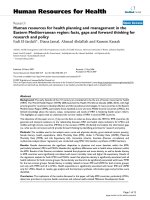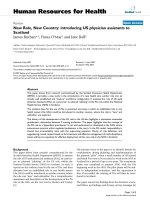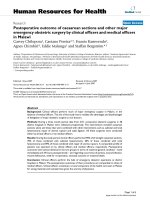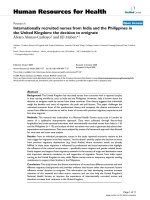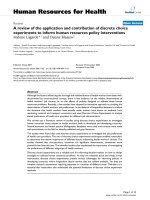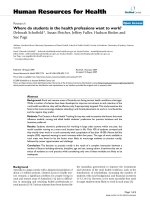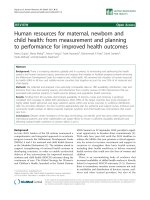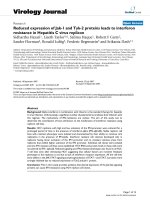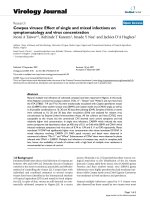báo cáo sinh học:" Workforce analysis using data mining and linear regression to understand HIV/AIDS prevalence patterns" pdf
Bạn đang xem bản rút gọn của tài liệu. Xem và tải ngay bản đầy đủ của tài liệu tại đây (204.03 KB, 6 trang )
BioMed Central
Page 1 of 6
(page number not for citation purposes)
Human Resources for Health
Open Access
Research
Workforce analysis using data mining and linear regression to
understand HIV/AIDS prevalence patterns
Elizabeth A Madigan*
1
, Olivier Louis Curet
2
and Miklos Zrinyi
3
Address:
1
Frances Payne Bolton School of Nursing, Case Western Reserve, 10900, Euclid Ave., Cleveland OH 44106-4904, USA,
2
Frances Payne
Bolton School of Nursing, Case Western Reserve University, 10900 Euclid Ave., Cleveland OH 44106-4904, USA and
3
World Health Organization,
Geneva, Switzerland
Email: Elizabeth A Madigan* - ; Olivier Louis Curet - ; Miklos Zrinyi -
* Corresponding author
Abstract
Background: The achievement of the Millennium Development Goals (MDGs) depends on
sufficient supply of health workforce in each country. Although country-level data support this
contention, it has been difficult to evaluate health workforce supply and MDG outcomes at the
country level. The purpose of the study was to examine the association between the health
workforce, particularly the nursing workforce, and the achievement of the MDGs, taking into
account other factors known to influence health status, such as socioeconomic indicators.
Methods: A merged data set that includes country-level MDG outcomes, workforce statistics, and
general socioeconomic indicators was utilized for the present study. Data were obtained from the
Global Human Resources for Health Atlas 2004, the WHO Statistical Information System
(WHOSIS) 2000, UN Fund for Development and Population Assistance (UNFDPA) 2000, the
International Council of Nurses "Nursing in the World", and the WHO/UNAIDS database.
Results: The main factors in understanding HIV/AIDS prevalence rates are physician density
followed by female literacy rates and nursing density in the country. Using general linear model
approaches, increased physician and nurse density (number of physicians or nurses per population)
was associated with lower adult HIV/AIDS prevalence rate, even when controlling for
socioeconomic indicators.
Conclusion: Increased nurse and physician density are associated with improved health outcomes,
suggesting that countries aiming to attain the MDGs related to HIV/AIDS would do well to invest
in their health workforce. Implications for international and country level policy are discussed.
Background
The socio-political impact of HIV/AIDS is increasingly
being identified as a global crisis, rather than only a health
crisis. There are estimates that generations of economic
development and progress will be woefully reduced by the
pandemic and that the socio-political fall-out due to HIV/
AIDS has only started. Complacency in the developed
world is risky because of the global nature of the world
economic markets and the inter-dependencies for trade
and manufacturing that are complex and multi-national.
Nonetheless, data regarding mortality, especially infant
mortality, and life expectancy indicate marked disparities
between rich and poor countries [1].
Published: 31 January 2008
Human Resources for Health 2008, 6:2 doi:10.1186/1478-4491-6-2
Received: 4 December 2006
Accepted: 31 January 2008
This article is available from: />© 2008 Madigan et al; licensee BioMed Central Ltd.
This is an Open Access article distributed under the terms of the Creative Commons Attribution License ( />),
which permits unrestricted use, distribution, and reproduction in any medium, provided the original work is properly cited.
Human Resources for Health 2008, 6:2 />Page 2 of 6
(page number not for citation purposes)
One of the United Nations Millennium Development
Goals (MDGs) is to reverse the spread of HIV/AIDS by
2015. Providing safe and effective anti-retroviral medica-
tions to HIV positive patients in developing countries
will help enhance positive health outcomes [2]. How-
ever, in addition to the provision of anti-retroviral med-
ications, there are additional health system factors that
may influence the achievement of the MDGs. One of
these factors is the health care workforce itself. In the case
of Antiretroviral Drugs (ARVs), the influence of the
healthcare workforce is obvious. Healthcare workers are
required to provide the medication and to teach patients
about and monitor both side effects and effectiveness of
the ARVs.
The WHO, in addition to focusing on basic public health
and epidemiology, also focuses on workforce develop-
ment, making recommendations to Ministries of Health
on health care workforce utilization and deployment.
Indeed, for 2006, the World Health Day theme was work-
force based: Working Together for Health. This is, in part,
due to the serious implications of workforce migration
from the developing to the developed world but also try-
ing to match the numbers and types of health care workers
(skill mix) to country level needs.
Of particular focus in this paper is the contributions
made by nursing professionals. The workforce migration
issues are most acute in nursing, in part due to societal
and economic conditions in many countries of the
world. As most nurses in the world are female, gender
politics, educational inequalities, and wage disparities
are driving forces for migration to countries where wages
are higher, there is more public respect for the profes-
sion, and nurses have the opportunity for professional
advancement [3].
There is widespread recognition that the factors associated
with health are multifactorial and include not only
health-related risk factors but also social determinants
such as poverty, social status, education, employment and
other social factors [4]. Thus the purpose of this study was
to investigate the relationships of different sets of factors
(e.g. social, economic, and health care workforce factors)
on HIV/AIDS prevalence rates.
Methods
Data for the study were derived from a number of WHO
and NGO sources. Human resources for health were
derived from the Global Health Atlas of Health Work-
force 2004 [5]. Health and mortality indicators were
obtained from the WHO Statistical Information System
(WHOSIS) 2000 [6]. Literacy indicators were collected
from UN Fund for Development and Population Assist-
ance (UNFDPA) 2000 [7]. The presence of regulatory
bodies for nursing and nursing associations was pro-
vided by the International Council of Nurses 2004. Reg-
ulation for nursing practice, nursing posts in Ministries
of Health and schooling required to become a registered
nurse (RN) were obtained from "Nursing in the World"
4th ed., 2000 [8]. HIV/AIDS prevalence rates (2003 esti-
mates) were obtained from the WHO/UNAIDS database
[9]. The data from the various data sources were merged
into one file at the country level for analysis.
The variables in the data set included the following : 1)
number of nurses per 100 000 population; 2) number of
midwives per 100 000 population; 3) number of nurses
and midwives per 100 000 population; 3) number of
physicians per 100 000 population; 4) the presence of
nursing regulatory bodies at the national level; 5) the
presence of a national nursing association; 6) whether
there is regulation for nursing practice; 7) the presence of
a WHO Collaborating Centre for nursing (WHO CC); 8)
the years of schooling required to become a registered
nurse; 9) government expenditure on health as a per-
centage of total expenditure on health; 10) governmen-
tal expenditure on health as a percentage of total general
government expenditure; 11) out of pocket expenditure
on health as a percentage of private expenditure on
health; 12) per capita expenditure on health (USD); 13)
per capita expenditure on health in international dollars;
14) private expenditure on health as percentage of total
expenditure on health; 15) social security expenditure
on health as percentage of general governmental expend-
iture on health; 16) total expenditure on health as per-
centage of gross domestic product; 17) total adult
literacy rate in %; 18) male adult literacy rate in %; and
19) female adult literacy rate in %. The outcome variable
was percentage of adults ages 15 to 49 living with HIV/
AIDS, the prevalence rate.
Analytic method
Two approaches were used for analysis: data mining
using classification and regression trees (CART) and
standard statistical analyses using ordinary least squares
regression. We chose to use both approaches to help us
determine, using the data mining approach, which vari-
ables were to be used in the standard regression
approach. This was particularly important because many
of the social and economic variables are multi-collinear.
Furthermore, because there was not a specific theoretical
model that guided our work (the use of social determi-
nants of health is a philosophical versus theoretical
approach), we did not want to exclude variables that
may not generally meet the threshold for a stepwise
regression approach.
CART is a data mining approach which has been applied
successfully in nursing and medical domains. CART can
Human Resources for Health 2008, 6:2 />Page 3 of 6
(page number not for citation purposes)
be used for prediction: as an example, CART can help
predict levels of HIV/AIDS prevalence rates based on pre-
viously learnt data. CART can also be used for interpreta-
tive purposes. For example, it can be used to understand
better patterns driving specific outcomes, such as HIV/
AIDS prevalence rates. In this study, both interpretation
and prediction were used.
CART splits data and finds patterns (or sequences of var-
iables explaining consistent outcomes) until all the ter-
minal nodes reach optimum similarity. The selection of
the variables is based on maximization of impurity
reduction (i.e. variables are selected by the algorithm in
the order that best explain the data). The example shown
in Figure 1 gives an illustration of patterns of higher inci-
dence of HIV/AIDS prevalence rates using the first three
variables to emerge from the CART analysis: physician
density, nurse density, and female literacy. The advan-
tage of CART is that new patterns in the data can be dis-
covered.
Results
Analysis of patterns
In the first part of the results, authors present a partial
description of the key variables that are associated with
HIV/AIDS prevalence rates. All variables described
under methods were used in developing the CART
models. In the next section, authors predict key selected
results based on CART to reveal patterns in the data. For
this analysis, the CART-derived decision tree and find-
ings show that physician density is the first key discrim-
inator between high and low HIV/AIDS prevalence
rates among the 194 countries for which data were
collected.
When analysing country profiles from 194 countries,
139 countries had a known level of HIV/AIDS preva-
lence rate (see Figure 1). The first break was physician
density at 29.5 doctors per 100 000 population. For
those 54 countries with a physician density < 29.5, the
second most important explanatory variable was female
literacy (> 76%). For the 49 countries with female liter-
acy < 76%, physician density > 2.44 was the next break
variable while for the 6 countries with female literacy >
76%, nursing density was the next break variable.
Physician density greater than 69 was the next break for
countries with physician density > 29.5. If physician
density was less than 69, then nurse density was the
next break for 11 countries. Further to these breaks, it
was difficult to draw conclusions because of the small
numbers of countries in additional nodes.
The majority of countries (90) had a physician density
> 29.5. These countries showed a lower HIV/AIDS prev-
alence rate compared to countries with physician den-
sity <29.5. When physician density was between 29.5
and 69, then nurse density emerged as the second most
important criterion associated with lower levels of HIV/
AIDS prevalence.
The average HIV/AIDS rate was 1.36 (9 countries) when
physician density was greater than 106, which indicated
that a very high level of physician density alone is not a
good predictor of lower levels of HIV/AIDS prevalence.
Thus, a CART-based approach provides a statistically
valid and logical explanation of complex predictions
including many variables of different types, even
qualitative.
Predictive modelling
One of the advantages of using CART – similar to other
benchmarking techniques – is the ability to predict out-
comes on the basis of existing clusters or rules classifying
the problem domain. For this research, we decided to use
CART derived clusters to help identify which variable(s)
can best explain HIV/AIDS prevalence rates in selected
countries around the world. The four countries selected
for this purpose were Botswana, Swaziland, Thailand,
and Zimbabwe. These four countries were selected on
the basis of 1) high levels of HIV/AIDS prevalence rates
and 2) the presence of data for the potential explanatory
variables. The selection of a different set of countries
would not have likely affected the results. The first step
was to eliminate them from the sample, one by one. The
second step considered recalculating new cluster values.
The third step assessed whether the nodes and their asso-
ciated values had changed, and if so, by how much. In
order to perform this analysis, authors compared each
country profile in the new cluster tree and assessed the
variation between predicted values and actual values of
HIV/AIDS prevalence rates.
The top level discriminators for HIV/AIDS prevalenceFigure 1
The top level discriminators for HIV/AIDS prevalence.
Physician
density
>29.5/100 000
Female literacy
>76%
Physician
density >
69/100 000
Physician
density > 2.44
Nursing
density> 43.66
Nursing
density> 229
Physician
density > 106
no
yes
no
yes
no
yes
no
yes
no
yes
no
yes
no
yes
129.5/44=2.94
44.2/5 = 8.84
151/5= 30.3
0.1/1 = 0.1
21.5/1=21.5
8.6/10=0.86
22.9/70=0.33
12.3/9=1.36
Human Resources for Health 2008, 6:2 />Page 4 of 6
(page number not for citation purposes)
CART produced very accurate (greater than 95% accu-
racy) outcomes using the methods described in Table 1.
In the case of Swaziland, the accuracy rose to 100%.
Smith, Scherer and Hauser [10] argued that when apply-
ing CART, a 97.2% accuracy level should be considered
as "effective".
Standard multiple regression analyses
Standard ordinary least squares regression was performed
using some of the same variables used in the CART
approach, with the intent to build the best explanatory
model (highest explained variance and theoretically
important independent variables). Because of non-nor-
mal distribution of HIV/AIDS prevalence rates, the log of
the HIV/AIDS prevalence rates was used. The statistical
assumptions for multiple regression were examined and
met. Because there was multiple co-linearity for some of
the independent variables, particularly the socio-eco-
nomic ones, the final model contains two independent
variables (physician density and nurse density) and one
covariate (total per capita expenditure on health in inter-
national dollars). The final model was significant (F =
28.0, p < .001) with 36% explained variance (adj R
2
=
.36). The workforce variables, when controlling for the
per capita expenditure on health, were both significant:
physician density with standardized regression coeffi-
cients (beta) of -0.52 and nurse density = -0.22. Most sim-
ply, this is the change in the log percentage of adults ages
15 to 49 with HIV for a unit change in the independent
variable. The interpretation, therefore, is that even when
controlling for per capita expenditures on health, both
physician and nurse density make a contribution to HIV/
AIDS prevalence rates for those between 15 to 49 years of
age. When controlling for physician density, nurse density
had an independent association with HIV/AIDS preva-
lence rates for the 15 to 49 age group. Of note, per capita
expenditure on health in international dollars had less rel-
ative influence on prevalence rates than either of the
workforce variables (beta = 0.17, p = 0.04) (See Table 2).
Discussion
This paper describes how a data mining approach and
standard statistical analyses were able to support the link
between health workforce composition and HIV/AIDS
prevalence rates in selected countries. In summary, nurs-
ing and physician density were both associated with HIV/
AIDS prevalence rates. The other important variable was
female literacy level. There were a number of variables
that did not emerge in the data mining analysis that have
been conventionally used to explain HIV/AIDS preva-
lence, in particular socioeconomic status variables, such
as expenditures on health and gross domestic product.
There are a number of explanations for our findings. Con-
sistent with the emphasis on the social determinants of
health, there is evidence that higher overall educational
attainment for both genders was associated with lower
prevalence rates of HIV/AIDS in Uganda [11]. Similar
trends were identified in multi-country reviews where
HIV/AIDS prevalence rates fell among the more educated
segments of the population, likely in response to educa-
tional campaigns related to safer sex practices [12]. Thus,
our findings on female literacy are consistent with the
findings from other research and consistent with Mar-
Table 1: Accuracy of CART for predicting HIV/AIDS prevalence rates
Predicted HIV/
AIDS prevalence
rates
Actual HIV/AIDS
prevalence rates
(% of adults ages
15 to 49 with HIV)
Δ Female literacy (%) Physician density
(# per 100 000)
Nurse density (#
per 100 000)
Botswana 38.8 37.3 -1.5 79.8 28.76 241.08
Swaziland 38.8 38.8 0 78.6 17.62 320.32
Zimbabwe 28.9 24.6 -4.3 84.6 5.73 54.16
Thailand 0.6 1.5 0.9 93.9 30.08 161.7
Σ 107.1 102.2 -4.9
Table 2: Regression results from OLS regression (N = 144)
Unstandardized regression
coefficient
Standardized regression
coefficient
t value p value
Physician density per 100 k 006 52 5.55 <.001
Nurse density per 100 k 001 22 2.31 .02
Per capita total
expenditures on health in
international $
.000 .17 2.04 .04
Adj R
2
= 0.36; F = 28.0, p < .001
Human Resources for Health 2008, 6:2 />Page 5 of 6
(page number not for citation purposes)
mot's contention that improvement in health requires
focus on more than just the health sector.
In countries where HIV/AIDS over-stressed the health care
system and where pharmaceutical treatments are not
available or are not widely available, home-based care,
organized and delivered by nurses, may be the only avail-
able form of health care. Thus an investment in home care
nursing in these countries can reduce the spread of HIV/
AIDS through community and public health nursing
approaches [13].
To lessen the impact of HIV/AIDS on health care systems
globally will require a multi-faceted approach. It may not
be sufficient to simply request more financial support
without revising current approaches to train and retain
nurses and physicians and to increase female literacy.
Governments may want to consider programs specifically
targeted to strengthen and alternatively distribute the
nursing workforce given that our findings showed nurse
density having an association with HIV/AIDS prevalence
rates. Strengthening the nursing workforce may also
require additional investments in education to prepare
additional number of nurses where there is an absolute
shortage of personnel. Any such programs will also need
to consider improving the working conditions of nurses to
ensure that they do not fall victims to the disease they help
to prevent through occupational exposure. Concurrently,
there will have to be multi-sectoral efforts to improve the
status of women through education. A recent paper iden-
tified "economic, social, and political empowerment of
women" as a key necessary driver behind new policies on
HIV/AIDS [14]. Our data did confirm the impact of
female literacy in combination with nurse density on pos-
itive HIV/AIDS outcomes. Thus continued efforts on
increasing female literacy through investment and the
development of strategies to promote the schooling of
girls may be helpful in addressing the HIV/AIDS pan-
demic [15].
There are areas for further research which will have to be
addressed. Data obtained for nurses in this study could
not differentiate between the various educational back-
ground and practice of nurses worldwide. Had we been
able to run a more detailed analysis aided by accurate
description of the nursing workforce, results would have
allowed for more precision concerning the impact on
HIV/AIDS outcomes. Another limitation was the lack of
ability to separate the number of midwives and their con-
tributions to preventing HIV/AIDS from the nursing data.
There are large variations in practice; in some countries
midwives have their independent practice, in other coun-
tries nurses who receive midwifery training do both, while
a third scenario is where all midwives must be trained
nurses. We acknowledge that there is an increased need to
have trained HIV/AIDS health care providers, especially in
areas where resources are scarce [16]. Yet we did not have
data on the degree or extent of HIV/AIDS training among
health care providers included in the present study.
Finally, current HIV/AIDS prevalence is in large part a
reflection of historical workforce composition. A cross-
sectional examination as presented here has limitations
between data of different ages and the temporal and com-
plex nature of health for persons with HIV/AIDS, whereby
the availability of ARVs and the workforce interact with
social determinants of health like HIV/AIDS prevalence.
In addition, further country-level information on how
nursing is integrated within the culture and within the
health care system of that particular country may be
informative in identifying best nursing workforce prac-
tices for health care structure, licensure/registration, scope
of practice, education and support of nursing education,
collaboration with physicians, and the use of traditional
or community health care workers. New models are
needed to assess HIV/AIDS testing, care, and treatment
impact on patients and their communities, all of which
are largely influenced by culture and setting.
There are a number of limitations to our study. First, we
were using country level data and there are some countries
where prevalence reports are not made public. The inclu-
sion of these countries would have benefited this research.
Second, by the use of a reduced dataset, we risked over-
simplifying complex political and health care system char-
acteristics that could have modified results. Third, because
HIV/AIDS is often associated with stigma in many parts of
the world, we may have overlooked the effect of such fac-
tors in the absence of accurate data. Fourth, because nurs-
ing workforce educational levels widely varied, we could
not distinguish the contributions made by the various lev-
els of nurses. Fifth, the data sources were from different
years and different sources of information, which may
have resulted in missing some of the dynamic nature of
the change in the variables used in the combined data
base. Finally, our study variables indicate correlations and
we are not implying cause-and-effect relationships.
Conclusion
Looking at our outcomes, it is evident that nursing density
has a significant association with HIV/AIDS outcomes in
many countries. Investment in the nursing workforce by
creating and supporting additional nursing education
programs may have a positive impact on HIV/AIDS prev-
alence rates in many developing nations. In addition to
the preparation of new nurses and midwives, increasing
satisfaction of the currently employed and improving
their working conditions may decrease nurse migration
[3]. Work by WHO and NGOs in influencing health pol-
icy to assist governmental agencies to better utilize nurses
Publish with Bio Med Central and every
scientist can read your work free of charge
"BioMed Central will be the most significant development for
disseminating the results of biomedical research in our lifetime."
Sir Paul Nurse, Cancer Research UK
Your research papers will be:
available free of charge to the entire biomedical community
peer reviewed and published immediately upon acceptance
cited in PubMed and archived on PubMed Central
yours — you keep the copyright
Submit your manuscript here:
/>BioMedcentral
Human Resources for Health 2008, 6:2 />Page 6 of 6
(page number not for citation purposes)
Publish with Bio Med Central and every
scientist can read your work free of charge
"BioMed Central will be the most significant development for
disseminating the results of biomedical research in our lifetime."
Sir Paul Nurse, Cancer Research UK
Your research papers will be:
available free of charge to the entire biomedical community
peer reviewed and published immediately upon acceptance
cited in PubMed and archived on PubMed Central
yours — you keep the copyright
Submit your manuscript here:
/>BioMedcentral
and midwives' unique contributions to reducing HIV/
AIDS infections may also have an impact upon MDG
achievements. These policies should walk hand-in-hand
with work by NGOs to support and assist governments to
increase female literacy that may have a pay-off in lower
HIV/AIDS prevalence rates.
Attainment of the MDG for HIV/AIDS will not be
achieved by opening up pharmaceutical treatment in the
form of ARVs without a commensurate investment in the
health care workforce which provides the necessary care
for patients living with HIV/AIDS. Rightfully, much inter-
national attention is currently focused on the unequal
access to pharmaceutical treatment for HIV/AIDS patients.
But even if the drugs were widely available at low cost
tomorrow, the current, insufficient number of health per-
sonnel would not be enough to match the millions of
infected individuals waiting for the attention of health
care worker.
Competing interests
The authors have no competing financial interests. Dr
Zrinyi was formerly employed by the WHO but has no
current financial or other ties to the WHO.
Authors' contributions
MZ developed the merged data set. OLC performed the
data mining. EAM performed the multiple regression
analysis. The generation of the idea and writing of the
paper was a three way effort in drafting and revising the
final copy. All three authors approved the final version.
Acknowledgements
The authors are also grateful to Dr Jean Yan, WHO Chief Nurse Scientist
for her comments on earlier versions of the paper and for her support of
the idea. Dr Curet is grateful to Deloitte Touche Tohmatsu, and particu-
larly Mike Stoneking, for supporting this research. Dr Curet also wishes to
thank Christine Beck, APRN, BC, MSN/MA, NP-C, CNE for her valuable
input to this paper.
References
1. Sanders D, Chopra M: Two key issues for the new WHO lead-
ership. The Lancet 2003, 361:172.
2. Wainberg MA: HIV drugs – enlightened policy for global
health. N Engl J Med 2005, 352:747-750.
3. Buchan J, Calman L: The Global Shortage of Registered Nurses:
An overview of issues and actions. [ />shortage.pdf]. International Council of Nurses
4. Marmot M: Social determinants of health inequalities. Lancet
2005, 365:1005-1006.
5. Global Atlas of Health Workforce 2004 [ />globalatlas/default.asp].
6. WHO Statistical Information System (WHOSIS) 2000 [http:/
/www.who.int/whosis/en/index.html].
7. UN Fund for Development and Population Assistance
(UNFDPA) 2000 [ />].
8. International Council of Nurses: "Nursing in the World". 4th edi-
tion. Tokyo Japan, The International Nursing Foundation of Japan;
2000.
9. WHO/UNAIDS database [ />]
10. Smith BL, Scherer WT, Hauser TA: Data mining tools for the sup-
port of traffic signal timing plan development. Proceedings 80th
Annual Meeting of TRB Washington, D.C 2001.
11. de Walque D, Nakiyingi-Miiro JS, Busingye J, Whitworth JA: Chang-
ing association between schooling levels and HIV-1 infection
over 11 years in a rural population cohort in south-west
Uganda. Trop Med Int Health 2000, 10:993-1001.
12. Hargreaves JR, Glynn JR: Educational attainment and HIV-1
infection in developing countries: a systematic review. Trop
Med Int Health 2002, 7:489-498.
13. Weidle PJ, Wamai N, Solberg P, Liechty C, Sendagala S, Were W,
Mermin J, Buchacz K, Behumbiize P, Ransom RL, Bunnell R: Adher-
ence to antiretroviral therapy in a home-based AIDS care
programme in rural Uganda. Lancet 2006, 368:1587-1594.
14. Akiki FS: The focus on women Kampala declaration: Ugandan
women call for action on HIV/AIDS. BMJ 2002, 324:247.
15. Wojcicki JM: Socioeconomic status as a risk factor for HIV
infection in women in East, Central and Southern Africa: a
systematic review. J Biosoc Sci 2005, 37:1-36.
16. Reynolds SJ, Bartlett JG, Quinn TC, Beyrer C: Antiretroviral ther-
apy where resources are limited. N Engl J Med 2003,
348:1806-1809.
Publish with Bio Med Central and every
scientist can read your work free of charge
"BioMed Central will be the most significant development for
disseminating the results of biomedical research in our lifetime."
Sir Paul Nurse, Cancer Research UK
Your research papers will be:
available free of charge to the entire biomedical community
peer reviewed and published immediately upon acceptance
cited in PubMed and archived on PubMed Central
yours — you keep the copyright
Submit your manuscript here:
/>BioMedcentral
